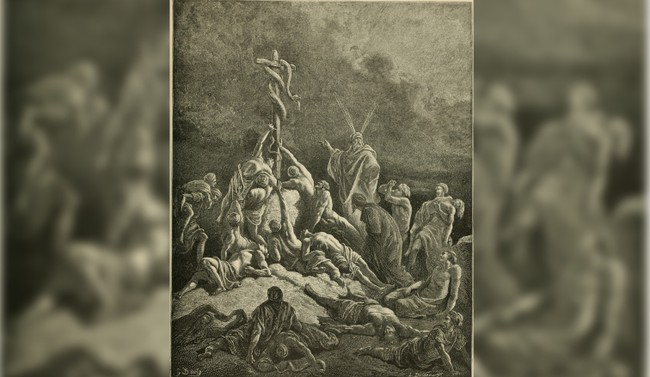We support our Publishers and Content Creators. You can view this story on their website by CLICKING HERE.

I always love the parallels between the Old and New Testaments; they show us that God’s Word is one big narrative and that He rewards our faithful study with nuggets like these.
Advertisement
I recently heard a sermon that contained one of my favorite Old Testament parallels to the story of Jesus. Dr. Albert Mohler is preaching through the book of Numbers with his congregation. In chapter 21, we find this account:
From Mount Hor they set out by the way to the Red Sea, to go around the land of Edom. And the people became impatient on the way. And the people spoke against God and against Moses, “Why have you brought us up out of Egypt to die in the wilderness? For there is no food and no water, and we loathe this worthless food.”
Numbers 21:4-5 (ESV)
Oh, what a shock. The Israelites complained in the wilderness again. But God made them regret their complaint with, to quote the great Dusty Davies from “Twister,” “imminent rueage.”
Numbers 21:6 tells us, “Then the Lord sent fiery serpents among the people, and they bit the people, so that many people of Israel died.”
Fiery serpents? That sounds nasty. Mohler explains:
So the Lord sends fiery serpents. And, you know, if you hear this, it sounds like serpents which are made of fire. No, the fire is the bite. The fire is the bite. And there are a lot of venomous snakes, a lot of very deadly venomous snakes in this part of the world. There are adders and there are vipers, There are cobras. Could well be that this was a carpet viper, very common all over the desert. And they have a horrifying bite.
And there are some of these snakes that have a slower acting venom, such that the one who is bitten has a horrifying, painful death that may not be at all quick, but is absolutely horrifying. We’re told that the Lord sent these snakes, these serpents.
Now remember, remember that the serpent has a certain unmistakable symbolism for God’s people. And so this is clearly a curse. And there are those who are dying.
Advertisement
Related: Sunday Thoughts: From Rebellion to Sacrifice
The people asked Moses to pray to the Lord on their behalf because, as Mohler puts it, “They understand that Moses can’t deliver them, and so they asked Moses to mediate before God that he would give them relief.” So Moses chose to stand in the gap to repent for his people:
And the people came to Moses and said, “We have sinned, for we have spoken against the Lord and against you. Pray to the Lord, that he take away the serpents from us.” So Moses prayed for the people. And the Lord said to Moses, “Make a fiery serpent and set it on a pole, and everyone who is bitten, when he sees it, shall live.” So Moses made a bronze serpent and set it on a pole. And if a serpent bit anyone, he would look at the bronze serpent and live.
Numbers 21:7-9 (ESV)
Mohler points out that “in the flow of biblical history and in the flow of biblical theology, this is just massive. This is massive because Jesus will refer to it.”
When he met with Nicodemus under cover of night, Jesus mentioned the bronze serpent to him. “And as Moses lifted up the serpent in the wilderness, so must the Son of Man be lifted up, that whoever believes in him may have eternal life” (John 3:14-15, ESV).
After the triumphal entry into Jerusalem, Jesus told his followers, “And I, when I am lifted up from the earth, will draw all people to myself” (John 12:32, ESV).
Advertisement
Mohler notes that we can’t deny that scripture is one big, full story:
I don’t understand how anyone who has read the Bible can be unsure at all of its divine inspiration. I just don’t know how that’s possible. You know, it would be possible if we’re studying just an ancient religious text and the more we study it, the more it falls apart.
Well, we could just say, ‘Well, that’s just a historical representation of a people who tried to put a religion together, couldn’t keep their story straight.’ There’s no straighter story than what we find from the Old Testament to the New.
He continues:
It’s such a wonderful God-honoring thing. It is because it helps us to look to the Scripture and say, oh, this isn’t an isolated text. We don’t just take one chapter out of numbers and study it as if it stands on its own. It doesn’t stand on its own.
It has to be related to God’s unfolding story. It has to be related to creation in retrospect. It has to be related to the Fall in retrospect. It has to be related to the creation of Israel as God’s people, the salvation of God’s people from captivity to Pharaoh and Egypt and then their disobedience and even here.
And yet what we see here is the limitation. This snake could not save in any sense of eternity. Death will still come, but the death will not be by the fiery serpent’s bite if they look and see this serpent and they are saved. And it is Christ himself who makes very clear he is that serpent in the ultimate fulfillment, even as he is the mediator in his ultimate fulfillment.
Advertisement
The big narrative of the Bible is exciting, and it’s always rewarding to see how various Bible stories work together to uphold God’s story.
It’s also encouraging to know that Jesus did for us what a prophet and a homemade metal snake never could.

 Conservative
Conservative  Search
Search Trending
Trending Current News
Current News 







